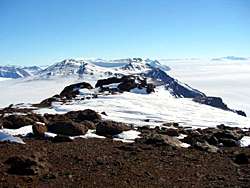Uncovering climate change clues in Antarctica's icy depths

New studies of the East Antarctic Ice Sheet have shown that climate change is having a more considerable impact than first thought.
The East Antarctic Ice Sheet (EAIS) holds enough ice to raise global sea level by about 60 metres. But because surface temperatures across East Antarctica are well below freezing point, this ice has long been thought to be relatively stable, and thus unlikely to contribute significantly to sea level rise during the next few centuries.
However, new field-based studies of ice sheet response to climate warming and sea level increase after the last ice age about 20,000 years ago suggest that parts of the ice sheet may respond more rapidly to global climate change than previously assumed.
Most of the contribution to sea level from melted ice occurs along the coastal perimeter of East Antarctica, where the slow moving ice sheet meets the ocean. An alternative mechanism of ice sheet melt to sea level is via large outlet glaciers which stream through deep and extensive basins that act like drainage channels. Little is known about the relative amounts of these two mechanisms.
The research, by Dr Duanne White and Associate Professor Damian Gore of Macquarie University and Dr David Fink from ANSTO, is published in the most recent edition of the journal Geology. In this publication, the authors describe their study of large ice streams that drain a large proportion of the snow that falls on the Antarctic Ice Sheet to the sea.
“These outlet glaciers can quickly move ice from the ice sheet to the coast through these basins and are thus a strong linkage between the ice sheet and the ocean, providing a means of more rapidly transferring changes in oceanic and atmospheric conditions to changes in the size of the ice sheet than would otherwise be expected,” explains Dr White. “However, the large area, remoteness and complexity of the ice streams means they have been difficult to study before now.”
The researchers investigated changes in ice sheet elevation in the Lambert Glacier-Amery Ice Shelf region, which drains an estimated ~15% of East Antarctica’s ice, to see how it had reacted to past climate and sea level changes. With the logistic support of the Australian Antarctic Division, they spent three summers in this remote part of Antarctica. They trawled across the mountain ranges that flank the Lambert Glacier ice stream, collecting numerous boulders scattered over the surface which had been deposited by the ice when it was higher than today.
The team then used the ANTARES particle accelerator at ANSTO to measure the concentration of rare, long-lived radioactive isotopes in the rocks using a new, innovative technique called cosmogenic surface exposure dating. These radioisotopes are produced in the rock when they are bombarded by high energy cosmic rays that penetrate the earth’s atmosphere effectively creating “nuclear clocks” which measure the time since the boulder was released from its icy prison. By correlating exposure age with altitude, the researchers used the mountain ranges that protrude above the ice sheet as ‘dipsticks’ to measure past ice sheet elevation.
The results indicate that at the end of the last ice age, ice thickness in the Lambert Glacier ice streaming region began to decrease a few thousand years earlier than ice sheet retreat measured at adjacent coastal regions, and that there was a reduced delay between regional climate warming and resultant lowering of the ice stream several hundred kilometres inland.
The authors conclude that ice stream regions of the East Antarctic Ice Sheet show an enhanced sensitivity to climate warming and sea level rise than previously assumed.
















